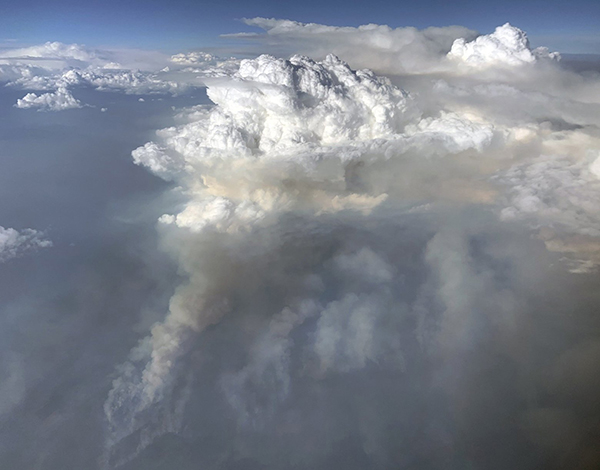A .gov website belongs to an official government organization in the United States.
A lock () or https:// means you've safely connected to the .gov website. Share sensitive information only on official, secure websites.
8 August 2019
adapted from the story by CIRES Communications

Analysis of massive 2017 cloud of wildfire smoke will help calibrate climate models, including modeling of nuclear winter and geoengineering.
Thunderstorms generated by a group of giant wildfires in 2017 injected a small volcano's worth of aerosol into the stratosphere, creating a smoke plume that lasted for almost nine months. NOAA and the Cooperative Institute for Research in Environmental Sciences (CIRES) at the University of Colorado Boulder researchers studying the plume found that black carbon or soot in the smoke was key to the plume's rapid rise: the soot absorbed solar radiation, heating the surrounding air and allowing the plume to quickly rise.
The billowing smoke clouds provided researchers with an ideal opportunity to test climate models that estimate how long the particulate cloud would persist – after achieving a maximum altitude of 23 km, the smoke plume remained in the stratosphere for many months. These models are also important in understanding the climate effects of nuclear war or geoengineering.
"We compared observations with model calculations of the smoke plume. That helped us understand why the smoke plume rose so high and persisted so long, which can be applied to other stratospheric aerosol injections, such as from volcanoes or nuclear explosions," said NOAA ESRL CSD scientist Karen Rosenlof, a member of the author team that also included scientists from CU Boulder, Naval Research, Rutgers and other institutions. The journal Science published the findings.
During the summer of 2017, wildfires raged across the Pacific Northwest. On August 12 in British Columbia, a group of fires and ideal weather conditions produced five near-simultaneous towering clouds of smoke or pyrocumulonimbus clouds that lofted smoke high into the stratosphere. Within two months, the plume rose from its initial height of about 12 km up to 23 km and persisted in the atmosphere for much longer – satellites could spot it even after eight months.

"The forest fire smoke was an ideal case study for us because it was so well observed by satellites," said lead author Pengfei Yu, a former CIRES scientist at NOAA ESRL CSD, now at the Institute for Environment and Climate Research at Jinan University in Guangzhou, China.
Instruments on two satellites – the International Space Station and NASA's CALIPSO – and on NOAA's balloon-borne Portable Optical Particle Spectrometer (POPS), provided the aerosol measurements the researchers needed.
Yu and his colleagues compared those observations with results from a global climate and chemistry model to get a match for how high up the smoke rose and how long it lasted in the atmosphere. With measurements of the rise rate and evolution of the smoke plume, the researchers could estimate the amount of black carbon in the smoke and how quickly the organic particulate material was destroyed in the stratosphere.
They found that the plume's rapid rise could only be explained by the presence of black carbon or soot, which comprised about 2 percent of the total mass of the smoke. The soot absorbed solar radiation, heated the surrounding air and forced the plume high into the atmosphere.
Next, the team modeled the degradation of the smoke plume in the atmosphere. They found that to mimic the smoke's observed rate of decay over the multi-month plume, there had to be a relatively slow loss of organic carbon (through photochemical processes) that previous nuclear winter studies had assumed to be very rapid.
"We have a better understanding of how our models represent smoke. And because we can model this process, we know we can model other aerosol-related processes in the atmosphere," said co-author Ru-Shan Gao, a NOAA scientist who is participating in FIREX-AQ, a massive NOAA- and NASA- led mission to investigate the chemistry of wildfire smoke.
Yu, P., O.B. Toon, C.G. Bardeen, Y. Zhu, K.H. Rosenlof, R.W. Portmann, T.D. Thornberry, R.-S. Gao, S.M. Davis, E. Wolf, J. de Gouw, D.A. Peterson, M.D. Fromm, and A. Robock, Black carbon lofts wildfire smoke high into the stratosphere to form a persistent plume, Science, doi:10.1126/science.aax1748, 2019.
In 2017, western Canadian wildfires injected smoke into the stratosphere that was detectable by satellites for more than 8 months. The smoke plume rose from 12 to 23 kilometers within 2 months owing to solar heating of black carbon, extending the lifetime and latitudinal spread. Comparisons of model simulations to the rate of observed lofting indicate that 2% of the smoke mass was black carbon. The observed smoke lifetime in the stratosphere was 40% shorter than calculated with a standard model that does not consider photochemical loss of organic carbon. Photochemistry is represented by using an empirical ozone-organics reaction probability that matches the observed smoke decay. The observed rapid plume rise, latitudinal spread, and photochemical reactions provide new insights into potential global climate impacts from nuclear war.